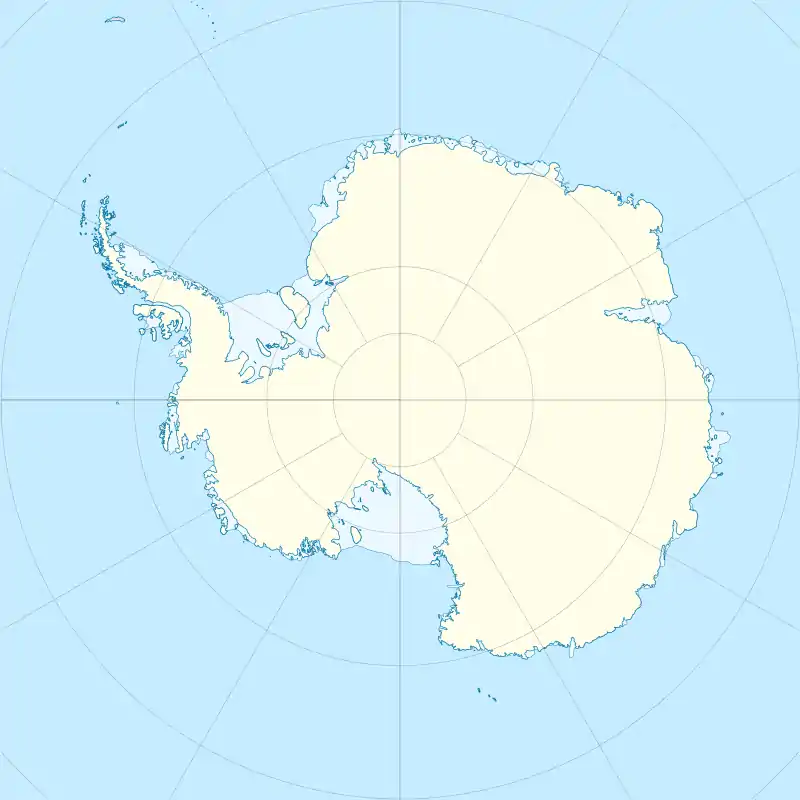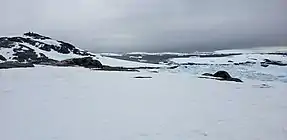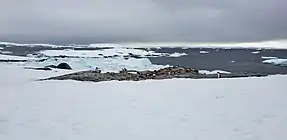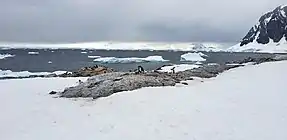.jpg.webp) Icebergs and Booth Island | |
 Booth Island Location in Antarctica | |
| Geography | |
|---|---|
| Location | Antarctica |
| Coordinates | 65°4′48″S 64°0′0″W / 65.08000°S 64.00000°W |
| Archipelago | Wilhelm Archipelago |
| Length | 8 km (5 mi) |
| Highest elevation | 980 m (3220 ft) |
| Highest point | Wandel Peak |
| Administration | |
| Administered under the Antarctic Treaty System | |
Booth Island (or Wandel Island) is a rugged, Y-shaped island, 8 kilometres (5 mi) long and rising to 980 m (3,215 ft) off the northwest coast of Kyiv Peninsula in Graham Land, Antarctica in the northeastern part of the Wilhelm Archipelago. The narrow passage between the island and the mainland is the Lemaire Channel.
History
The island was discovered and named by a German expedition under Eduard Dallmann 1873–74, probably for Oskar Booth or Stanley Booth, or both, members of the Hamburg Geographical Society at that time. The Belgian Antarctic Expedition of 1897–1899 applied the name "Wandel Island", for Danish polar explorer and hydrographer Carl Frederick Wandel, but the United States Advisory Committee on Antarctic Names rejected the name in favor of the earlier Booth Island.[1][2] The name Wandel was retained for the island's highest point.[3]
Although many of the island's features were probably first seen by Dallmann's expedition, the island was not charted in detail until the Third French Antarctic Expedition, 1903–1905.[4][5] The majority of the island's features were named by expedition leader Jean-Baptiste Charcot. The names he gave were generally for expedition members, notable French scientists, or friends and family of Charcot.
The sea slug species Curnon granulosa was first described in 1906 from a single specimen found at 40 m depth at Booth Island.[6][7]
Geography
Booth Island has an irregular Y-shape, with a long narrow peninsula that stretches north off the main body of the island, indented on its west coast by a large bay known as Port Charcot, and a shorter rocky peninsula to the west. It is separated from the mainland to the east by a narrow passage called the Lemaire Channel.[1][2] To the west, Libois Bay separates Booth Island from tiny Cholet Island, and Rallier Channel separates it from Rallier Island.[8][9]
Coastal features
Turquet Point marks the north extremity of the island, at the tip of the long narrow peninsula sometimes called the Mount Lacroix peninsula for the large mountain that surmounts it.[4][10] To the west along the coast is Brouardel Point, a headland north of Port Charcot.[10]
Port Charcot indents the northwest shore of Booth Island for 1.5 nautical miles (3 kilometres) at its widest. Charcot established the French expedition's winter base at Port Charcot in 1904.[11] A cairn at Port Charcot, with a wooden pillar and a plaque inscribed with the names of the members of the French expedition, has been designated a Historic Site or Monument (HSM 28), following a proposal by Argentina to the Antarctic Treaty Consultative Meeting.[12]
Along the southern shore of Port Charcot, Vanssay Point marks the extremity of a small peninsula which extends north into the water of the port.[13] To the west, Français Cove, named for one of Charcot's ships, indents the south shore of Port Charcot.[14] A small island, Sögen Island, forms the east side of Francais Cove.[15]
Paumelle Point marks the south side of the entrance to Libois Bay and the northwest end of the peninsula that forms the west extremity of the island.[16] The end of the rocky western peninsula is indented by a small cove called Roland Bay, whose south end is marked by Hervéou Point, the western extremity of the peninsula.[17][18] Salpêtrière Bay indents the south coast of the western peninsula for 1 nautical mile (1.9 km) between Hervéou Point, and Poste Point to the east.[19] Charcot named the bay for the Hôpital de la Salpêtrière, a Paris hospital where his father, neurologist Jean-Martin Charcot, founded a clinic.[20]
Roullin Point marks the island's southern tip.[5]
Inland features
Mount Lacroix is a prominent mountain with red vertical cliffs and a rounded summit, 640 metres (2,100 ft) high, surmounting the island's northeast peninsula. It was named by Charcot after French mineralogist Alfred Lacroix.[21] Cléry Peak is a peak on the north side of Mount Lacroix.[22]
There are several high peaks on the north–south trending ridge of the island. Mount Guéguen is a sharp rocky peak, 365 metres (1,200 ft) high overlooking Port Charcot at the north end of the main body of the island.[23] About 0.25 nautical miles (0.5 km) to the south is Jeanne Hill, standing 195 m (640 ft) high and named for Charcot's sister.[24] About 0.25 nautical miles (0.5 km) to the south of that is Louise Peak, which stands 625 metres (2,050 ft) high.[24] Standing 1 nmi (2 km) south is Gourdon Peak.[25][26]
Approximately 0.5 nmi (1 km) south of Gourdon is the highest point of the island, Wandel Peak, which stands 980 metres (3,215 ft) high.[3][23] In 2003, Australian mountaineer Damien Gildea called it "one of the most challenging unclimbed objectives on the Antarctic Peninsula".[27] On 15 February 2006 the peak was reached by a group of Spanish alpinists, who still avoided the last 10–15 metres (32.8–49.2 ft) of the mushroomlike top.[28]
See also
References
- 1 2 "Booth Island". Composite Gazetteer of Antarctica. Scientific Committee on Antarctic Research.
- 1 2 "Booth Island (UK)". Composite Gazetteer of Antarctica. Scientific Committee on Antarctic Research.
- 1 2 "Wandel Peak". Composite Gazetteer of Antarctica. Scientific Committee on Antarctic Research.
- 1 2 "Turquet Point". Geographic Names Information System. United States Geological Survey, United States Department of the Interior. Retrieved 1 December 2015.
- 1 2 "Roullin Point". Geographic Names Information System. United States Geological Survey. Retrieved 1 December 2015.
- ↑ MolluscaBase (2019). MolluscaBase. Curnon granulosa (Vayssière, 1906). Accessed through: World Register of Marine Species at: http://www.marinespecies.org/aphia.php?p=taxdetails&id=1320723 on 2019-09-05
- ↑ Wägele, H., Barnes, D. K. A., and Bullough, L. W. (1995) Redescription of Charcotia granulosa Vayssière, 1906 (Nudibranchia: Arminoidea: Charcotiidae) from Signy Island, Antarctica. Journal of Molluscan Studies 61: 197-207.
- ↑ "Libois Bay". Geographic Names Information System. United States Geological Survey. Retrieved 13 June 2013.
- ↑ "Rallier Island". Geographic Names Information System. United States Geological Survey. Retrieved 13 June 2013.
- 1 2 "Brouardel Point". Geographic Names Information System. United States Geological Survey. Retrieved 1 December 2015.
- ↑ "Charcot, Port". Geographic Names Information System. United States Geological Survey, United States Department of the Interior. Retrieved 3 November 2011.
- ↑ "List of Historic Sites and Monuments approved by the ATCM (2012)" (PDF). Antarctic Treaty Secretariat. 2012. Retrieved 28 October 2013.
- ↑ "Vanssay Point". Geographic Names Information System. United States Geological Survey. Retrieved 1 December 2015.
- ↑ "Français Cove". Geographic Names Information System. United States Geological Survey, United States Department of the Interior. Retrieved 6 April 2012.
- ↑ "Français Cove". Geographic Names Information System. United States Geological Survey, United States Department of the Interior. Retrieved 6 April 2012.
- ↑ "Paumelle Point". Geographic Names Information System. United States Geological Survey. Retrieved 1 December 2015.
- ↑ "Roland Bay". Geographic Names Information System. United States Geological Survey. Retrieved 1 December 2015.
- ↑ "Hervéou Point". Geographic Names Information System. United States Geological Survey. Retrieved 15 June 2012.
- ↑ "Poste Point". Geographic Names Information System. United States Geological Survey. Retrieved 1 December 2015.
- ↑ "Salpêtrière Bay". Geographic Names Information System. United States Geological Survey. Retrieved 1 December 2015.
- ↑ "Mount Lacroix". Geographic Names Information System. United States Geological Survey, United States Department of the Interior. Retrieved 23 May 2013.
- ↑ "Cléry Peak". Geographic Names Information System. United States Geological Survey, United States Department of the Interior. Retrieved 23 May 2013.
- 1 2 "Mount Guéguen". Geographic Names Information System. United States Geological Survey, United States Department of the Interior. Retrieved 10 May 2012.
- 1 2 "Jeanne Hill". Geographic Names Information System. United States Geological Survey, United States Department of the Interior. Retrieved 18 July 2012.
- ↑ "Louise Peak". Geographic Names Information System. United States Geological Survey, United States Department of the Interior. Retrieved 4 July 2013.
- ↑ "Gourdon Peak". Geographic Names Information System. United States Geological Survey, United States Department of the Interior. Retrieved 2 May 2012.
- ↑ Gildea, Damien (2003). Harlin (ed.). "Climbs and Expeditions: Antarctic Peninsula, Summary of Activities". American Alpine Journal. Vol. 77, no. 45. p. 335. Retrieved 10 December 2020.
- ↑ Tamayo, José Carlos (2006). Harlin, John III (ed.). "Antarctica, Antarctic Peninsula, Mt. Shackleton, South Face-West Ridge; Wandel Peak, North Ridge to Summit Mushroom". American Alpine Journal. Vol. 48, no. 80. Seattle: Mountaineers Books. p. 294. ISBN 1-933056-01-0. Archived from the original on 10 December 2020. Retrieved 10 December 2020.


